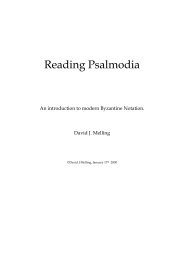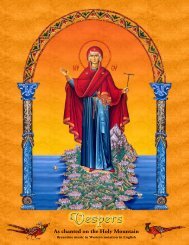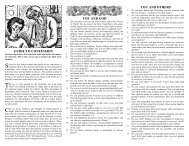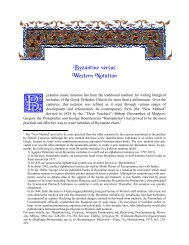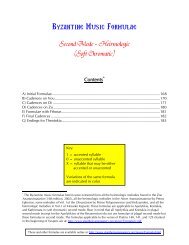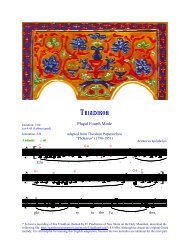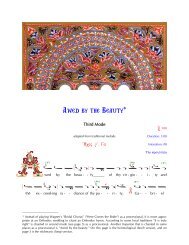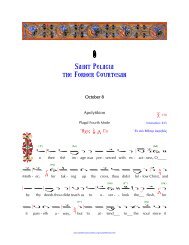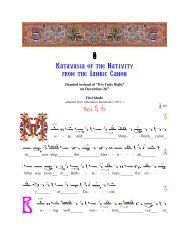Rubrics for the Divine Liturgy of St. James - St. Anthony's Monastery
Rubrics for the Divine Liturgy of St. James - St. Anthony's Monastery
Rubrics for the Divine Liturgy of St. James - St. Anthony's Monastery
You also want an ePaper? Increase the reach of your titles
YUMPU automatically turns print PDFs into web optimized ePapers that Google loves.
<strong>Rubrics</strong> <strong>for</strong> <strong>the</strong><br />
<strong>Divine</strong> <strong>Liturgy</strong> <strong>of</strong> <strong>St</strong>. <strong>James</strong><br />
T<br />
he <strong>Divine</strong> <strong>Liturgy</strong> <strong>of</strong> <strong>St</strong>. <strong>James</strong> <strong>the</strong> Bro<strong>the</strong>r <strong>of</strong> God is <strong>the</strong> first apostolic liturgy. The liturgies <strong>of</strong> <strong>St</strong>.<br />
John Chrysostom and <strong>St</strong>. Basil <strong>the</strong> Great were based on it and replaced it, according to <strong>St</strong>. Nicodemus<br />
<strong>the</strong> Hagiorite. 1 Today, it is celebrated only on October 23 rd , <strong>the</strong> feast day <strong>of</strong> <strong>St</strong>. <strong>James</strong>.<br />
The music <strong>for</strong> <strong>the</strong> hymn “Only-begotten Son” (page 126), <strong>the</strong> responses <strong>of</strong> <strong>the</strong> petitions (“Lord, have<br />
mercy”) (pages 88-123), <strong>the</strong> Thrice-holy Hymn (pages 183-197), and <strong>the</strong> “Alleluia” (pages 210-218) following<br />
<strong>the</strong> epistle reading are identical to those used in <strong>the</strong> <strong>Divine</strong> <strong>Liturgy</strong> <strong>of</strong> <strong>St</strong>. John Chrysostom.<br />
Between <strong>the</strong> epistle and gospel readings, <strong>the</strong>re is a set <strong>of</strong> petitions intoned by <strong>the</strong> deacon. The response<br />
<strong>for</strong> each petition is “Lord, have mercy,” except <strong>for</strong> <strong>the</strong> final petition, which has <strong>the</strong> response “Lord, have<br />
mercy. Lord, have mercy. Lord, have mercy.” After <strong>the</strong> gospel reading, <strong>the</strong> deacon intones ano<strong>the</strong>r set <strong>of</strong> petitions.<br />
The response to <strong>the</strong> first five petitions is a single “Lord, have mercy,” <strong>the</strong> response to <strong>the</strong> next six is<br />
“Grant this, O Lord,” and <strong>the</strong> response to <strong>the</strong> final petition <strong>of</strong> <strong>the</strong> deacon is “To Thee, O Lord.” The cherubic<br />
hymn <strong>for</strong> <strong>the</strong> <strong>Divine</strong> <strong>Liturgy</strong> <strong>of</strong> <strong>St</strong>. <strong>James</strong> is <strong>the</strong> cherubic hymn <strong>of</strong> Holy Saturday: “Let All Mortal Flesh” (see<br />
page 297).<br />
After <strong>the</strong> creed and <strong>the</strong> deacon’s petitions: “Let us love one ano<strong>the</strong>r with a holy kiss… Let us bow our<br />
heads unto <strong>the</strong> Lord,” <strong>the</strong> priest chants <strong>the</strong> hymn: “O magnify <strong>the</strong> Lord with me…” (see page 625) Immediately<br />
<strong>the</strong>reafter, <strong>the</strong> choir responds with <strong>the</strong> hymn: “The Holy Spirit shall come upon <strong>the</strong>e…” (see page 625).<br />
The responses <strong>for</strong> <strong>the</strong> anaphora are identical to <strong>the</strong> anaphora in <strong>the</strong> liturgy <strong>of</strong> <strong>St</strong>. John Chrysostom (see<br />
pages 303-367), with <strong>the</strong> difference that <strong>the</strong>re are eighteen petitions with <strong>the</strong> response, “Lord, have mercy”<br />
and <strong>the</strong>n one petition with <strong>the</strong> response, “Lord, have mercy. Lord, have mercy. Lord, have mercy.” preceding<br />
<strong>the</strong> petitions “Through <strong>the</strong> compassions…, Peace be unto all…, Let us stand well…,” etc.<br />
1 Vid. The Rudder, p. xxvii. <strong>St</strong>. Nicodemus <strong>the</strong> Hagiorite probably relied on <strong>the</strong> validity <strong>of</strong> a treatise (PG 45:849-852)<br />
attributed to <strong>St</strong>. Proclus (d. 446). Later scholars, however, (e.g., Swainson, C.A., The Greek Liturgies, Cambridge<br />
1884, and Brightman, F.E., Liturgies Eastern and Western I, Eastern Liturgies, Ox<strong>for</strong>d, 1896) question <strong>the</strong> validity <strong>of</strong><br />
<strong>the</strong>se statements and ascribe that treatise to a much later writer. Moreover, <strong>the</strong>y believe that <strong>the</strong> <strong>Liturgy</strong> <strong>of</strong> <strong>St</strong>. <strong>James</strong><br />
developed independently <strong>of</strong> and simultaneously with <strong>the</strong> o<strong>the</strong>r liturgies. (See also Fountouvlh, !Iwavnnou M., !Apanthvsei"<br />
eij" Leitourgika;" !Aporiva", Tovmo" DV, !Apostolikh; Diakoniva, !Aqhvna, 1994, sel. 49-50, and Conomos, Dimitri<br />
E., Byzantine Trisagia and Cheroubika <strong>of</strong> <strong>the</strong> Fourteenth and Fifteenth Centuries, pp. 13-18.)
At <strong>the</strong> consecration <strong>of</strong> <strong>the</strong> Holy Gifts, <strong>the</strong> deacon intones <strong>the</strong> petition “We believe and confess.” Then,<br />
instead <strong>of</strong> chanting “We hymn Thee…,” <strong>the</strong> choir chants <strong>the</strong> hymn: “We proclaim Thy death…” (see page<br />
626). The priest <strong>the</strong>n chants <strong>the</strong> hymn: “For Thy people…” (see page 626), and <strong>the</strong> choir responds by repeating<br />
three times <strong>the</strong> hymn: “Have mercy on us…” (see page 626).<br />
While <strong>the</strong> priest reads <strong>the</strong> long prayer “We <strong>of</strong>fer unto Thee, O Master…,” <strong>the</strong> choir quietly repeats many<br />
times <strong>the</strong> hymn: “Remember <strong>the</strong>m, O Lord our God” (see page 627). When <strong>the</strong> priest completes that prayer,<br />
he intones <strong>the</strong> petition: “Especially our all-holy, immaculate, most blessed…,” and <strong>the</strong> choir chants <strong>the</strong> hymn<br />
“Remember <strong>the</strong>m…” <strong>for</strong> <strong>the</strong> last time with a different melody (see page 628).<br />
After <strong>the</strong> petition “Grant unto us and <strong>the</strong>m…,” <strong>the</strong> choir chants <strong>the</strong> hymn: “Pardon, remit, and <strong>for</strong>give…”<br />
(see page 629).<br />
Following <strong>the</strong> deacon’s petition: “In <strong>the</strong> peace <strong>of</strong> Christ let us chant unto <strong>the</strong> Lord,” <strong>the</strong> clergy receive<br />
communion. According to Athonite rubrics, at this point in <strong>the</strong> liturgy (whe<strong>the</strong>r it be <strong>the</strong> <strong>Liturgy</strong> <strong>of</strong> <strong>St</strong>. John<br />
Chrysostom, <strong>St</strong>. Basil <strong>the</strong> Great, <strong>St</strong>. <strong>James</strong>, or <strong>the</strong> <strong>Liturgy</strong> <strong>of</strong> <strong>the</strong> Presanctified Gifts), <strong>the</strong> reader reads <strong>the</strong> precommunon<br />
prayers: “I believe, O Lord, and I confess…,” “Behold, I approach…,” “Receive me today…,”<br />
Tremble, O man…,” “Thou hast smitten me…,” “Into <strong>the</strong> splendour…,” “O man-befriending Master…,” and<br />
again “Receive me today….” The reader <strong>the</strong>n reads Psalms 33 (“I will bless <strong>the</strong> Lord…”) and 144 (“I will<br />
exalt Thee…”). After <strong>the</strong> reader has completed <strong>the</strong>se two psalms, <strong>the</strong> choir chants <strong>the</strong> communion hymn<br />
from <strong>the</strong> <strong>Liturgy</strong> <strong>of</strong> <strong>the</strong> Presanctified Gifts: “O Taste and See…” (see pages 613-617).<br />
While <strong>the</strong> faithful receive communion, <strong>the</strong> choir repeats <strong>the</strong> hymn: “Receive me today…” (see pages<br />
534-543).<br />
After <strong>the</strong> faithful have received communion, <strong>the</strong> choir chants <strong>the</strong> hymn: “Fill my mouth with Thy<br />
praise…” (see page 631).<br />
According to Athonite rubrics, at <strong>the</strong> end <strong>of</strong> every liturgy in which <strong>the</strong> faithful received communion, <strong>the</strong><br />
reader reads <strong>the</strong> thanskgiving prayers <strong>for</strong> holy communion while <strong>the</strong> priest distributes <strong>the</strong> antidoron.



